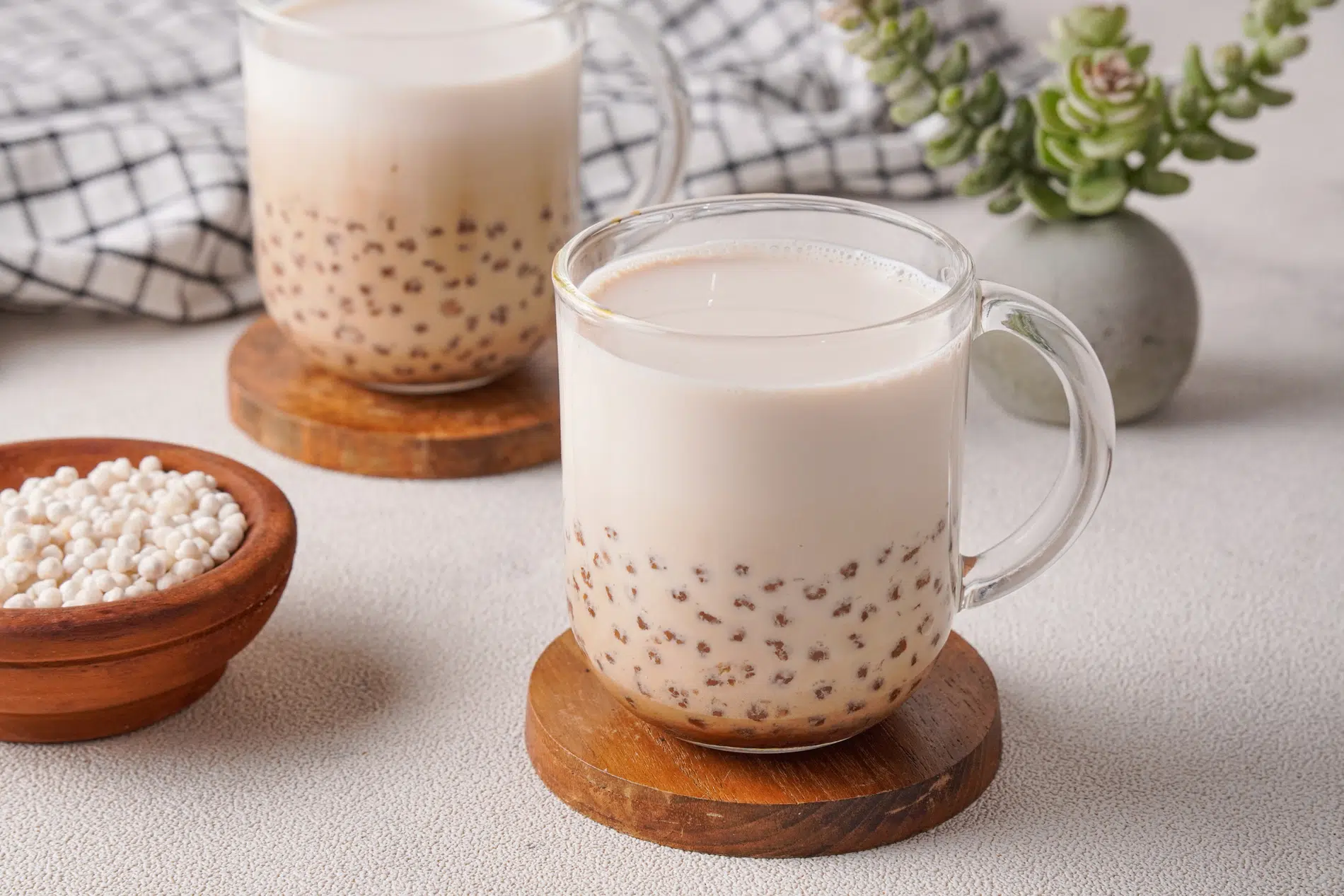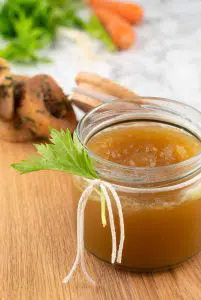How to Make Filipino Taho
Important Note: When you buy through our links, we may earn a commission. As an Amazon Associate we earn from qualifying purchases. Content, pricing, offers and availability are subject to change at any time - more info.

Ingredients
- 1 cup sago pearls tapioca pearls
- 4 cups soy milk
- ½ cup brown sugar
- ½ cup water
- ½ tsp vanilla extract optional
Instructions
- Boil 4 cups of water in a medium saucepan. Add sago pearls and cook for 10 minutes until translucent. Stir occasionally. Drain, rinse under cold water, and set aside.
- In a small saucepan, combine brown sugar and 1/2 cup water. Cook over medium heat for 5 minutes until sugar dissolves and mixture thickens. Remove from heat and add vanilla extract if using. Set aside.
- Heat soy milk in the medium saucepan until warm but not boiling.
- Divide sago pearls among 4 serving cups. Pour warm soy milk over pearls, filling each cup 3/4 full. Drizzle brown sugar syrup on top.
- Serve immediately.
Nutrition
Have you ever longed for a snack that allows you to travel halfway around the world without even leaving your own kitchen? Then look no further than the delightful Filipino taho! This is a traditional Filipino street food that combines silky smooth tofu, scrumptious syrup, and chewy tapioca pearls for a taste adventure that’s hard to resist. Trust us, once you’ve experienced the unique contrasts of textures and flavors in this recipe, you’ll understand why this snack has made its way into the hearts of so many Filipinos—and soon into yours!
Not only is Filipino taho a delicious treat, but it also comes with some intriguing culinary tidbits. For example, did you know that the process of transforming soybeans into the silky tofu used in this recipe has been perfected over centuries? Or that the use of tapioca pearls, also known as sago, dates back to ancient Southeast Asian cultures? So, you’ll be embarking on a culinary journey steeped in history! Now, with all these tantalizing details in mind, are you not eager to don that apron and whip up some Filipino taho in your own kitchen? Let’s dive into the recipe in the next section and get ready for a gastronomic adventure!
Yield & Servings
4 servings
Ingredients
1 cup uncooked sago pearls (tapioca pearls)
4 cups soy milk
½ cup brown sugar
½ cup water
½ teaspoon vanilla extract (optional)
Notable Equipment & Tools
Medium saucepan
Small saucepan
Strainer
4 serving cups or glasses
Step-by-step Instructions
Step 1: Gather and Prep Your Ingredients
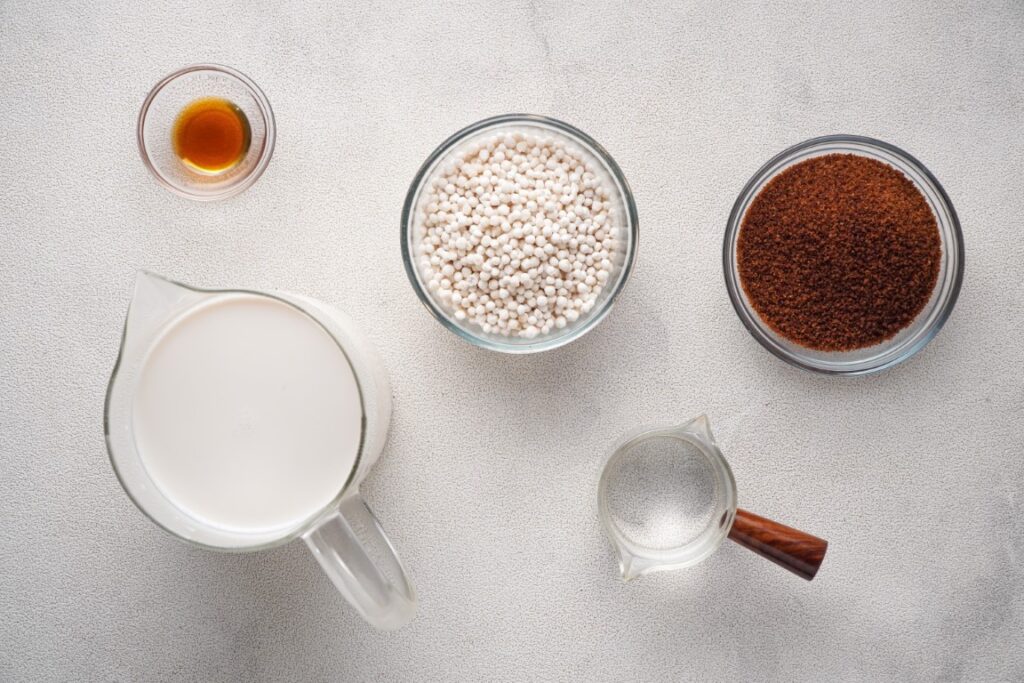
All ingredients ready? Let’s begin!
Step 2: Cook sago pearls

In a medium saucepan, bring 4 cups of water to a boil. Add the sago pearls and cook for 10 minutes or until they become translucent. Stir occasionally to prevent the pearls from sticking together. Once cooked, drain the sago pearls using a strainer and rinse them under cold water. Set aside.
Step 3: Prepare the syrup
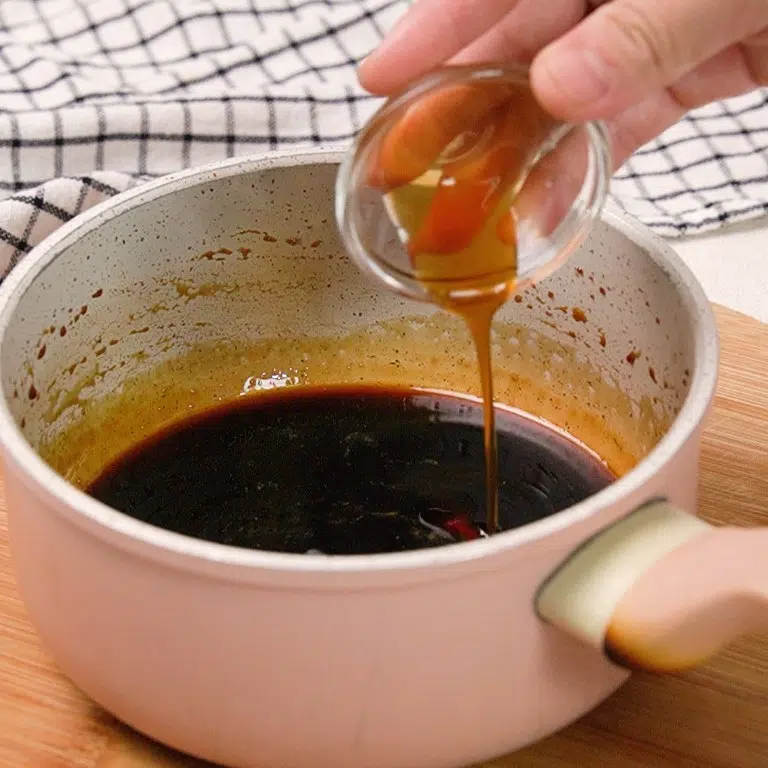
In a small saucepan, combine the brown sugar and 1/2 cup of water. Cook over medium heat, stirring occasionally, until the sugar has dissolved and the mixture has thickened slightly. This should take about 5 minutes. Remove from heat and stir in the vanilla extract if using. Set aside.
Step 4: Heat the soy milk
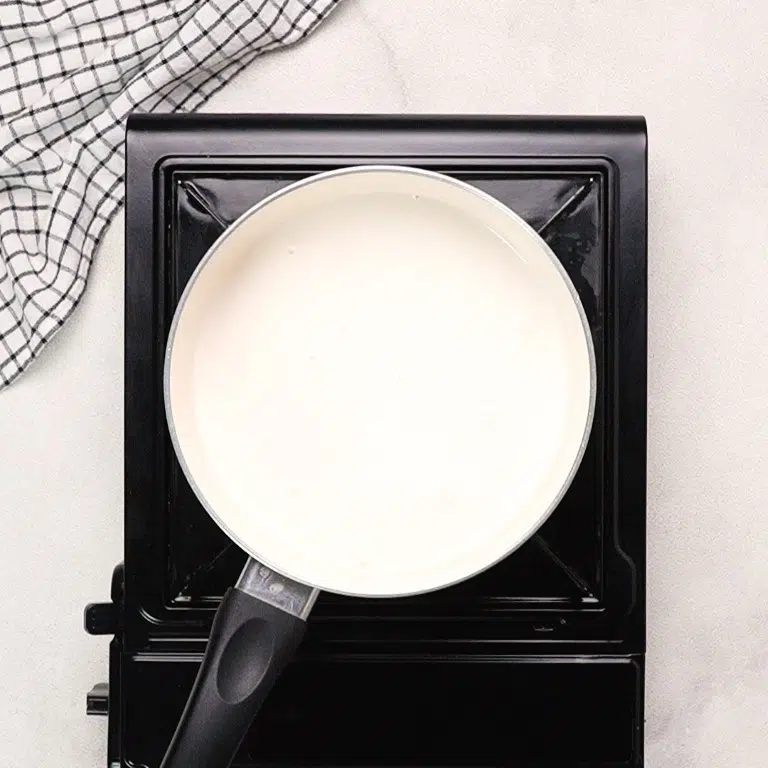
In the same medium saucepan used for the sago pearls, heat the soy milk over medium heat until it is warm but not boiling. Be careful not to overheat the soy milk, as it may curdle.
Step 5: Assemble the taho
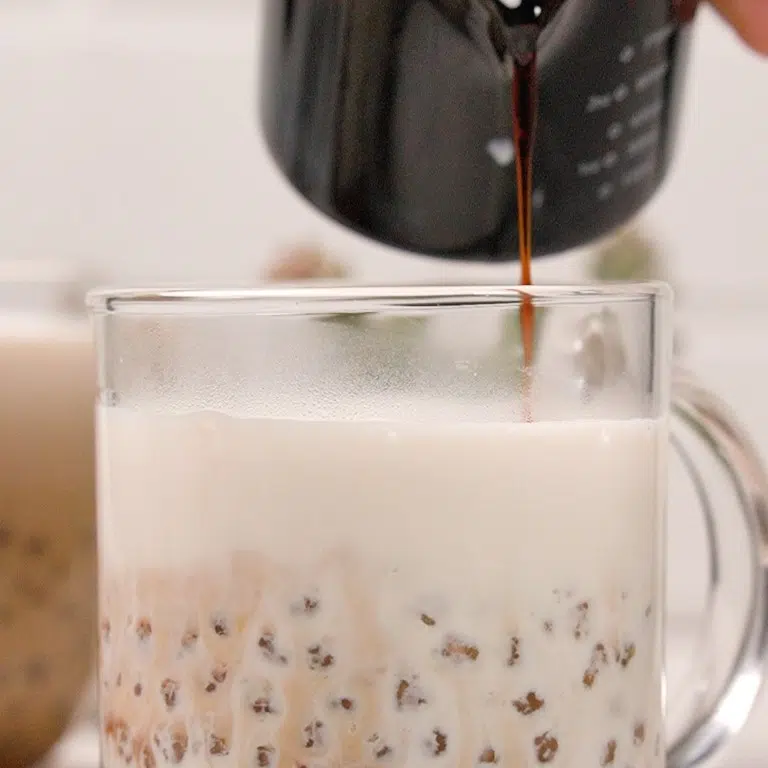
Divide the cooked sago pearls evenly among 4 serving cups or glasses. Pour the warm soy milk over the pearls, filling each cup about 3/4 full. Drizzle the brown sugar syrup over the top of each serving.
Step 6: Enjoy your homemade Filipino taho!
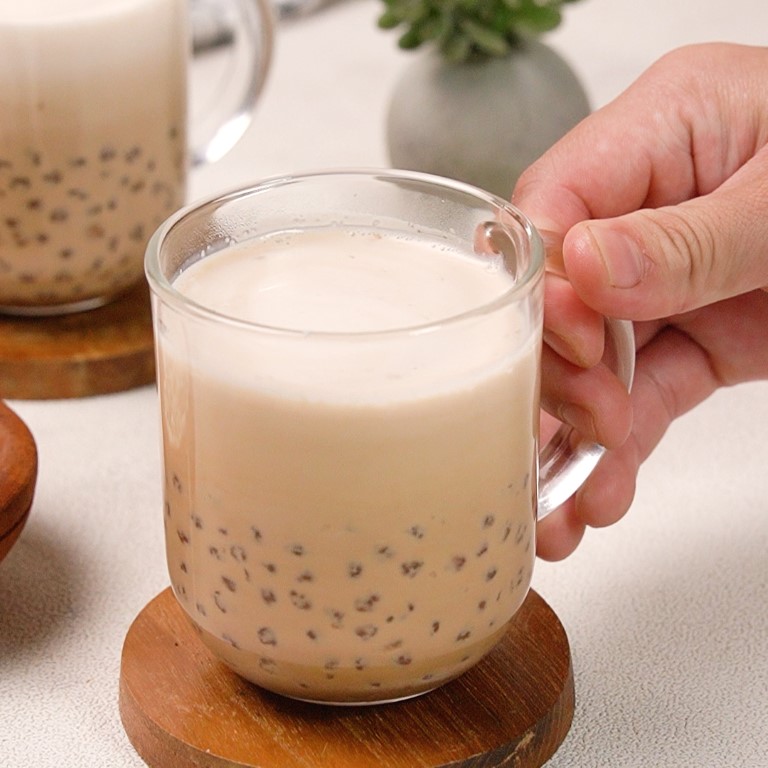
Serve immediately and enjoy your homemade Filipino taho!
Substitutions & Alternatives
Ahoy, adventurous cooks! We understand that variety is the spice of life, so we’ve got you covered with some lip-smacking substitutions and alternatives to give your Filipino taho a twist. Ready to embark on this culinary journey? Let’s go!
- Sago pearls: Tapioca pearls tend to be the most popular choice for taho, but if you’re in the mood for a little culinary exploration, you can try using rice balls or even chia seeds for a different texture. Just follow the cooking instructions on their respective packages, and you’ll be good to go.
- Soy milk: Not a fan of soy milk or have an allergy? Don’t fret! You can swap it out with almond milk, coconut milk, or even regular cow’s milk. Your taho will still taste fantastic, and we won’t tell anyone about your little switcheroo.
- Brown sugar: Looking to jazz up your syrup game? You can try using other sweeteners like honey, agave nectar, or even maple syrup. While it won’t be the traditional Filipino taho, we’re all about embracing global culinary creativity here!
- Vanilla extract: This one’s optional in the recipe, but let’s say you want to add a little flavor to your taho without deviating too far from the vanilla essence. Why not try almond extract, coconut extract, or even a hint of cinnamon? The world’s your oyster…or should we say, taho?
- Make it fruity: If you’re craving a little more pizzazz in your taho, add some diced fruits like mango, pineapple, or lychee on top. This tropical twist will transport you straight to a sunny beach, even if you’re just sitting in your kitchen.
- Get nutty: Want some extra crunch in your taho? Sprinkle some crushed peanuts, cashews, or almonds on top for added texture and flavor. Just be mindful of any nut allergies if you’re sharing your creation with others!
So there you have it, taho enthusiasts – a treasure trove of substitutions and alternatives to keep your culinary escapades fresh and exciting. Remember, it’s all about having fun and embracing your inner chef, so don’t be afraid to experiment with new ingredients and flavor combinations. Happy cooking!
Storage & Reheating
Fear not, fellow taho lovers, for the days of unfinished servings and wasted leftovers are gone! Here’s your ultimate guide to storing and reheating this delicious Filipino dessert, ensuring that every pearl and drop of syrup shall be savored to the fullest.
First, let’s talk storage. It’s best to store the three components of taho (sago pearls, soy milk, and syrup) separately to avoid any unwanted sogginess or flavor mingling. Simply transfer the cooked sago pearls into an airtight container, let them chillax in the refrigerator, and they’ll be good to go for up to 3-4 days. As for your syrup, keep it in a separate container and refrigerate it for the same amount of time. And finally, the soy milk can be stored in its original packaging, but make sure to use it within the expiry date mentioned on the carton.
Now, let’s bring the magic back with some reheating tips! When you’re ready to enjoy round two (or three) of your taho adventure, start by warming up the soy milk in a saucepan over low heat. Keep an eye on it, as soy milk can be a bit temperamental and may curdle if overheated. Once it’s warm and steamy, remove it from the heat.
As for the sago pearls, you have two options. You can either microwave them in a microwave-safe container for about 30 seconds to a minute or reheat them in a saucepan with a splash of water over low heat. Just stir them occasionally to ensure even heating.
And finally, our trusty syrup. Reheat it in a small saucepan over low heat, stirring it occasionally until it’s warm and luscious. But be warned, dear reader, for here lies a sneaky little science tidbit: sugar can be a culinary drama queen, prone to burning or crystallizing when reheated. So keep the heat low and your wits about you to avoid any kitchen mishaps.
Once all the components are warmed up, it’s time for the grand reunion! Assemble your taho by layering the sago pearls, soy milk, and syrup in your serving cups, and let the sweet symphony of flavors transport you to the vibrant streets of the Philippines. And there you have it — storage and reheating tips that’ll make even your leftovers taste like a fresh, homemade Filipino taho!
Serving Ideas
Now that you’ve mastered the art of making Filipino taho, it’s time to get creative with your serving ideas! This delightful and versatile dessert can be enjoyed in various ways, and here are some ideas that’ll impress your family and friends while celebrating global culinary heritage:
- Go tropical: Give your taho a tropical twist by adding a few chunks of ripe mango or pineapple to the mix. This fruity addition will not only add a pop of color but also a refreshing taste that’ll make you feel like you’re on a beach vacation.
- Jazz it up with jellies: For a fun and colorful touch, add some fruit-flavored jelly cubes to your taho. You can either make your own fruit jelly or buy pre-made ones from the store. Choose contrasting colors for a visually appealing dessert that’s bursting with flavor!
- Get nutty: Add a crunchy element to your taho by sprinkling some chopped nuts on top. Almonds, cashews, or peanuts would all make excellent additions to this dessert, not to mention an extra boost of protein to keep you feeling satisfied.
- Sweet and savory: For a unique twist, try adding a pinch of sea salt to the brown sugar syrup to create a salted caramel flavor. This sweet and savory combo will definitely surprise and delight your taste buds.
- Go green: To celebrate the power of plants, add a few fresh mint leaves to your taho. This will not only give it a refreshing taste but also a beautiful pop of green color.
- Tea time: For a soothing and aromatic addition, try steeping some tea leaves (such as jasmine or green tea) in the soy milk while heating it. This will give your taho a subtle tea flavor that’s perfect for unwinding after a long day.
- Cozy up with spices: As the weather gets cooler, consider adding some warming spices to your taho, like cinnamon, nutmeg, or even a pinch of ground ginger. These spices will not only make your taho smell heavenly but also add a touch of warmth to each bite.
Remember, these serving ideas are just a starting point for your culinary creativity! Feel free to mix and match different ingredients and flavors to create your own unique and delicious Filipino taho masterpieces. Enjoy experimenting and, most importantly, have fun!
Variations & Customization
There’s a world of possibilities when it comes to personalizing your Filipino taho, even for those with dietary restrictions or following specific diets. Here are some ideas to spark your creativity and make this delightful dessert fit your lifestyle:
- Vegan: Good news for the plant-based folks—this recipe is already vegan-friendly! However, you can always experiment with different plant-based milk options like almond, cashew, or oat milk to find your favorite flavor combination.
- Gluten-free: Sago pearls are naturally gluten-free, as they’re derived from tapioca. But be cautious when purchasing your sago pearls or tapioca pearls, as they sometimes contain added starches that may not be gluten-free. Always read the label to ensure the product you’re using is safe for your dietary needs.
- GAPS/AIP: To make this recipe compliant with the Gut and Psychology Syndrome (GAPS) diet or the Autoimmune Protocol (AIP) diet, you’ll need to replace the soy milk with a homemade coconut milk or any other GAPS/AIP-approved milk substitute. You can also swap out the brown sugar for honey or maple syrup to sweeten the dish.
- Keto: If you’re following a ketogenic diet, you’ll need to make a few adjustments. First, substitute the sago pearls with chia seeds or flaxseeds, which are both low in carbs and high in fiber. Next, replace the soy milk with full-fat coconut milk or heavy cream to increase the fat content. Lastly, swap the brown sugar for a keto-friendly sweetener like erythritol or stevia.
- Other popular variations: The beauty of Filipino taho is its adaptability! Feel free to play around with additional flavors and toppings to create your own unique version. Some ideas include adding fruit (like mango or strawberries), nuts (like almonds or cashews), or even a drizzle of chocolate or caramel sauce.
With these tips and tricks in your culinary arsenal, you’ll be able to whip up a customized Filipino taho that perfectly suits your taste buds and dietary needs. So go forth, get creative, and enjoy this delicious and adaptable dessert!
Notes & Tips
- Taho terrific: This Filipino street food favorite is a delightful combination of comfort and adventure, with its warm soy milk, chewy sago pearls, and sweet brown sugar syrup. Our recipe is easy to make at home, so why not impress your friends and family with a taste of the Philippines?
- Sago sagacity: Sago pearls can be finicky to cook, but fear not! Make sure to keep the water boiling while cooking the pearls and stir them occasionally to prevent sticking. The pearls should turn translucent once cooked, but if you find some stubborn opaque centers, give them a minute or two longer.
- Silky soy: When heating soy milk, take care not to let it boil, as it may curdle and ruin the smooth texture. Keep an eye on the heat and consider using a thermometer if you’re unsure. Around 160°F (70°C) should be just right – warm, but not boiling.
- Customize your creation: Feel free to experiment with different types of milk (almond, oat, or cow) or sweeteners (maple syrup, honey, or agave). You could even try adding a splash of pandan extract for a unique, fragrant twist!
- Time-saving tip: If you’re in a hurry, you can cook the sago pearls and prepare the brown sugar syrup in advance. Just store them separately in airtight containers in the fridge, and when you’re ready to enjoy, heat the pearls and soy milk before assembling your taho.
- End on a high note: To make your taho truly Instagram-worthy, drizzle the brown sugar syrup in a zigzag pattern or create a swirl on top. Don’t forget to snap a pic before digging in!
- The science of sago: The translucent, gelatinous texture of the sago pearls comes from the starch extracted from the sago palm tree. When heated, the starch molecules absorb water and swell, creating that distinctive, chewy consistency we all know and love.
So, roll up your sleeves and channel your inner Filipino street vendor as you whip up this delicious taho! It’s easier than you think, and you’ll be rewarded with a fun and flavorful dessert that’s sure to please. Enjoy, and happy cooking!
Common Mistakes
Not washing the sago pearls: Skipping the rinsing step after cooking the sago pearls can lead to a starchy and gooey texture in your taho. Make sure to rinse them under cold water to remove excess starch and prevent them from clumping together.
Overcooking the sago pearls: While it’s tempting to speed up the process by cooking the sago pearls longer or at a higher temperature, doing so can cause them to become mushy and lose their delightful chewy texture. Keep an eye on the clock and stir occasionally to ensure they cook evenly without overcooking.
Scorching the soy milk: It’s crucial to heat the soy milk gently without boiling it to avoid curdling. Remember, we want a smooth and silky taho, not a chunky mess! Use medium heat and be patient; slow and steady wins the race here.
Over-sweetening with the syrup: Though the brown sugar syrup adds a lovely flavor and sweetness to the taho, it’s easy to get carried away and pour too much. Do a taste test with a small amount first and adjust to your preference. You can always add more, but you can’t take it away!
Forgetting the global culinary heritage: Did you know that taho has a close cousin in Chinese cuisine called douhua or doufuhua? It’s a soft tofu dessert that is also served with sweet syrup. So, while you enjoy your Filipino taho, take a moment to appreciate the culinary connections and influences across different cultures.
Waiting too long to serve: Taho is best enjoyed immediately after assembly while the soy milk is still warm, and the sago pearls are soft and chewy. Sharing this delicious treat with family or friends straight away adds to the experience and creates a delightful, communal moment. So don’t delay – dig in and savor the goodness of homemade Filipino taho!
Health Risks & Benefits
As you dive into this delightful Filipino taho recipe, you’ll not only be transported to the tropical paradise of the Philippines, but you’ll also be savoring some fantastic health benefits. But, before we get into that, let’s address any potential health risks, so you can indulge in this treat worry-free.
First off, it’s essential to know that sago pearls, or tapioca pearls, are gluten-free. This makes taho a fantastic dessert option for those with celiac disease or gluten intolerance. However, if you have an allergy to latex or any other rubber products, be cautious when trying sago pearls, as they are derived from the same plant family. If you’re unsure, it’s best to consult your healthcare provider first.
Now, let’s talk about the fantastic benefits of this delicious dessert. Soy milk, one of the main ingredients, is an excellent source of protein and contains essential amino acids. It’s also a fantastic alternative for those who follow a plant-based diet or are lactose intolerant. Plus, soy milk brings a unique creaminess to this dish that will make you feel like you’re enjoying a luxurious treat.
Brown sugar, used to create the syrup, contains essential minerals like calcium, potassium, and iron, which can contribute to overall health. However, it’s always best to enjoy sugar in moderation, so feel free to adjust the amount of syrup to your preferred sweetness level.
Finally, the addition of vanilla extract not only adds a beautiful aroma and flavor to this dish but also contains antioxidants, which help protect your body from cell damage.
So go ahead, indulge in this homemade Filipino taho, and feel good knowing that you’re treating yourself to a dessert that not only tastes amazing but also has some surprising health benefits. Just remember to enjoy it responsibly and share with your friends and family to spread the joy of global culinary heritage!
Recipe History & Context
Taho, a classic Filipino street food, has been delighting taste buds across the Philippines for centuries. This sweet, comforting treat boasts a rich history that can be traced back to the arrival of Chinese immigrants in the country during the Spanish colonial period. The influence of Chinese cuisine in the Philippines is undeniable, and taho is a shining example of this culinary fusion.
Originally called douhua in Chinese, taho is a popular soy-based dessert that shares similarities with other Asian treats like the Indonesian kembang tahu and the Thai tao huay. The word taho itself is believed to have been derived from the Hokkien term tao-ho, which means soy milk. Thanks to the simplicity of its ingredients and the ease of preparation, taho quickly became a staple in Filipino households and a beloved street food snack.
The star of this delicious concoction is the humble soybean, a versatile and nutritious legume that has played a vital role in Asian diets for thousands of years. Soy milk, a key component of taho, is a rich and creamy liquid derived from ground, soaked, and cooked soybeans. Paired with chewy sago pearls and a drizzle of sweet syrup, taho is a delightful mix of textures and flavors that will transport your taste buds to the bustling streets of Manila.
While traditional taho vendors, known as magtataho, are still a common sight in the Philippines, this recipe allows you to bring the magic of Filipino street food right into your own kitchen. With just a few simple ingredients and steps, you’ll be whipping up an authentic batch of taho faster than you can say Mabuhay! Plus, you’ll be joining a centuries-old tradition that celebrates the rich culinary heritage of the Philippines and pays homage to the global influence of Chinese cuisine. So, grab your saucepans and let’s get cooking – it’s time to master the art of homemade taho!
Common Questions
Sago pearls are small, translucent balls made from the starch of the sago palm tree. They’re widely used in various Asian desserts for their chewy texture. If you don’t have access to sago pearls, you can substitute them with small tapioca pearls. Both sago and tapioca pearls offer a similar texture and appearance, making them a great alternative in this recipe. However, be mindful that cooking times may vary, so follow the package instructions for the best results.
Absolutely! You can use cow’s milk or any other plant-based milk like almond, rice, or oat milk to make this delicious Filipino taho. The taste and texture may vary slightly depending on the milk you choose, but the dessert will still be delectable. Just be cautious when heating the milk, as some types may curdle if overheated. Keep an eye on the milk as you heat it, and aim for a warm but not boiling temperature.
If you have any leftover taho, you can store it in the refrigerator for up to 3 days. Make sure to cover the serving cups or glasses with plastic wrap to keep the taho fresh. Before enjoying the leftovers, give the taho a gentle stir to mix any separated syrup and milk, and consider heating it briefly in the microwave for a warm, comforting treat.
The world is your oyster… or should we say, your taho! Feel free to get creative and add your favorite toppings or flavorings. Some popular additions include fresh fruit, like mango or strawberries, or even a sprinkle of crushed nuts or toasted coconut. You can also experiment with different flavored syrups, such as maple, caramel, or chocolate, to elevate your homemade Filipino taho to new heights. Just remember to balance the sweetness and flavors, so your taste buds can fully enjoy this delightful dessert.
